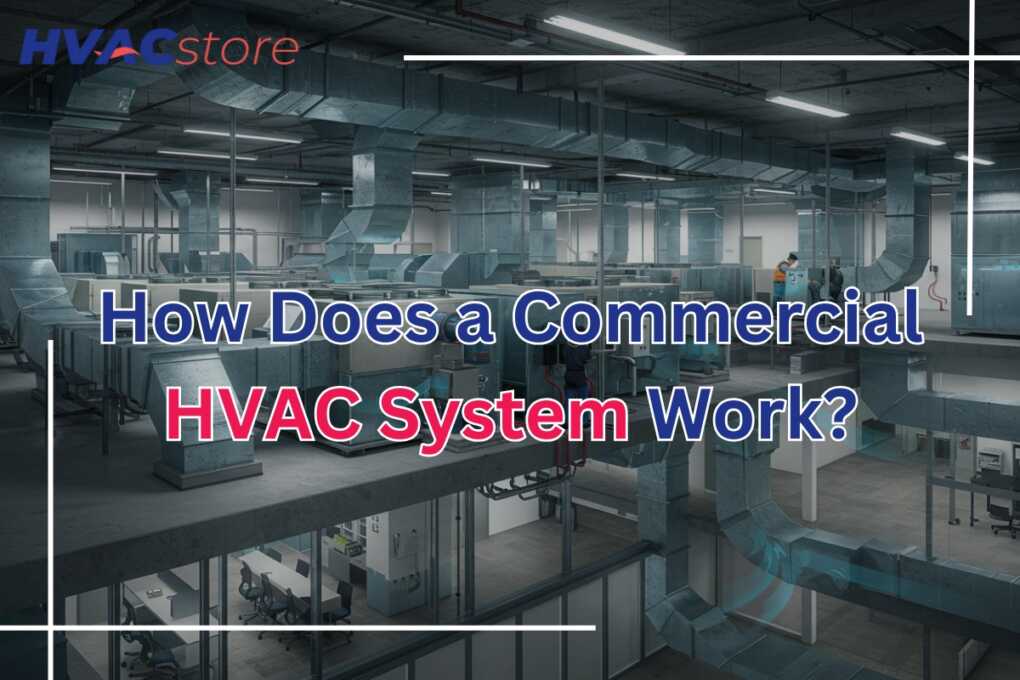
Walk into any office building, and you expect it to feel comfortable. The temperature should be just right, neither too hot nor too cold. You probably don’t think about the massive, complex system working behind the walls to make that happen.
Most business owners treat their HVAC system like a black box; they know it heats and cools the building, but that’s about it. Then something breaks, and they’re staring at a $15,000 repair bill, wondering how they got there.
Here’s what separates smart building managers from those who get blindsided by expensive surprises: they understand how their HVAC system actually works and what can go wrong before it does.
In addition to understanding how commercial HVAC systems operate, it’s crucial to ensure they are maintained by professionals who are familiar with the specific needs of your system. For businesses in Colorado, accessing reliable Commercial HVAC Services in Fort Collins can make a significant difference in system efficiency and longevity. These services provide expert maintenance and repair, ensuring that your HVAC system runs smoothly and effectively, minimizing downtime and energy costs. Regular professional check-ups can help identify potential issues before they become major problems, keeping your commercial environment comfortable and conducive to productivity.
Why Most People Don’t Get Commercial HVAC Systems
Your home AC unit and a commercial HVAC system are like comparing a bicycle to a semi-truck. They both get you from point A to point B, but the complexity difference is massive.
Commercial HVAC systems handle way more than just temperature. They’re managing air quality for hundreds of people, dealing with heat loads from computers and equipment, and running 12+ hours per day instead of a few hours here and there.
The scale changes everything. A residential unit might move 2,000 cubic feet of air per minute. Commercial systems can move 50,000+ CFM while maintaining precise temperature and humidity control across multiple zones.
Most contractors don’t explain this stuff because they assume you don’t want to know. Wrong assumption; understanding your system helps you spot problems early and avoid getting ripped off on unnecessary repairs.
Working with quality suppliers like HVAC Store means getting equipment designed for commercial demands, not oversized residential units that fail under commercial workloads.
The Three Systems That Actually Matter
Forget the technical jargon. Commercial HVAC breaks down into three basic jobs: heating stuff up, cooling stuff down, and moving air around. Everything else is just details.
- Heating systems use boilers, furnaces, or heat pumps to add warmth when it’s cold outside. Boilers heat water that travels through pipes. Furnaces burn gas or oil to heat air directly. Heat pumps steal warmth from outside air (even when it’s cold) and pump it inside.
- Cooling systems use chillers, standard AC units, or cooling towers to remove heat when it’s hot outside. Chillers work like giant refrigerators, cooling water that then cools air. Regular AC units work like your home system, but bigger. Cooling towers dump excess heat outside.
- Ventilation systems use fans and ductwork to move fresh air in and stale air out. This isn’t just about comfort; it’s about keeping carbon dioxide levels down and preventing sick building syndrome that kills productivity.
According to BuildOps HVAC experts, “The primary components of a commercial HVAC system include an air handling unit (AHU), a condenser unit, ductwork, and a thermostat,” working together to maintain building comfort.
The magic happens when these three systems work together instead of fighting each other. Poor coordination between heating, cooling, and ventilation is why some buildings feel great while others make you want to leave immediately.
How the Heating Process Actually Works
Commercial heating isn’t just “turn on the heat and wait.” The process involves multiple steps that can go wrong if you don’t understand them.
Boiler-based systems heat water to 120-180°F, then pump it through pipes to radiators, baseboard heaters, or air handlers throughout the building. The heated water gives up its warmth, then returns to the boiler to get heated again.
Furnace systems burn natural gas, propane, or oil to heat air directly. Fans blow building air across the hot heat exchanger, then distribute that warm air through ductwork. Simple concept, but the devil’s in the details.
Heat pump systems work like air conditioners running backwards. They extract heat from outside air (even at 20°F, there’s still heat energy) and concentrate it inside your building. Super efficient, but they struggle when outdoor temps drop below 10°F.
Thermostats control everything, but commercial thermostats are way more complex than the round dial on your wall at home. They manage multiple zones and scheduling and can even adjust based on occupancy levels.
The key insight most people miss: heating problems usually aren’t heating problems. They’re airflow problems, thermostat problems, or maintenance problems disguised as heating failures.
How the Cooling Process Really Works
Commercial cooling systems work harder than residential units because they’re fighting bigger heat loads from more sources: people, computers, lighting, windows, and equipment that runs all day.
Chiller systems are the workhorses of commercial cooling. They cool the water down to 42-45°F, then pump that cold water to air handlers throughout the building. Air gets blown across coils filled with cold water, cooling down before getting distributed through ducts.
Standard commercial AC unit systems work like giant versions of home air conditioners. Refrigerant gets compressed, condensed, and expanded to remove heat from indoor air. The difference is scale and redundancy.
Cooling towers handle the heat rejection for large systems. They use evaporation to cool water, which then goes back to chillers or condensers. You see these on top of big buildings; they’re basically giant radiators using water evaporation for cooling.
Variable refrigerant flow (VRF) systems can heat some zones while cooling others simultaneously. Perfect for buildings where the south side is hot from sun exposure, while the north side stays cool.
The cooling process fails when any part of the heat rejection chain breaks down. Dirty coils, low refrigerant, or failed fans all cause the same symptom: not enough cooling, but require different fixes.
Ventilation: The System Nobody Thinks About Until It’s Too Late
Ventilation keeps your indoor air from becoming a toxic soup of carbon dioxide, body odors, and chemical off-gassing from furniture and equipment. Yet it’s the most ignored part of HVAC systems.
- Fresh air intake brings outside air into the building through filters and conditioning equipment. This air gets mixed with return air from the building, heated or cooled as needed, then distributed.
- Exhaust systems remove stale air, moisture, and contaminants from bathrooms, kitchens, and other problem areas. Without proper exhaust, you get humidity problems and air quality issues.
- Air handlers are the lungs of the system. They contain fans, filters, heating/cooling coils, and mixing chambers that condition air before sending it through ductwork to your spaces.
- Ductwork design makes or breaks the whole system. Properly sized ducts deliver the right amount of air to each zone. Undersized ducts create pressure problems. Oversized ducts waste energy and money.
Poor ventilation causes headaches, fatigue, and reduced productivity; problems that cost significantly more than the energy required to run fans properly. Don’t cheap out on ventilation to save a few bucks on utility bills.
System Components That Break Most Often
Understanding which parts fail first helps you budget for maintenance and catch problems before they become expensive emergencies.
- Air filters clog up and restrict airflow, making your system work harder. Change them monthly, not “when you remember.” Dirty filters cause more HVAC problems than any other single issue.
- Fans and motors wear out from constant use. Bearings fail, belts break, and motors burn out. The good news? These are relatively cheap fixes if caught early.
- Thermostats and controls fail more often than mechanical parts because they’re sensitive to electrical issues. A $200 thermostat failure can shut down a $50,000 system.
- Refrigerant leaks in cooling systems cause gradually declining performance. Small leaks cost money every month in lost efficiency. Big leaks shut the system down completely.
- Heat exchangers in furnaces can crack, creating safety hazards and efficiency problems. These are expensive repairs that usually mean replacing the whole furnace.
The pattern? Cheap maintenance prevents expensive repairs. Most system failures happen because someone skipped routine upkeep to save money in the short term.
Benefits You Actually Get (Beyond Marketing Claims)
Commercial HVAC systems cost serious money upfront and ongoing. Here’s what you actually get for that investment:
- Energy efficiency from modern systems can cut utility bills 20-40% compared to older equipment. Variable speed drives, economizers, and smart controls make the biggest difference.
- Indoor air quality improvements reduce sick days and increase productivity. Clean air and proper ventilation are worth more than the energy costs to provide them.
- Temperature control keeps employees comfortable and customers happy. Uncomfortable people work slower and leave sooner, costing you money in ways that don’t show up on utility bills.
- Equipment protection from proper humidity control prevents damage to computers, furniture, and inventory. Controlling moisture saves money on replacement costs.
- Code compliance keeps you out of trouble with building inspectors and insurance companies. Modern HVAC systems meet current ventilation and safety requirements.
The real benefit? Reliability. A properly designed and maintained commercial HVAC system runs in the background without drama, letting you focus on your business instead of calling repair technicians.
Making Smart Decisions About Your System
Stop treating your HVAC system like a mystery box. Understanding how it works helps you make better decisions about maintenance, repairs, and replacements.
Know your system’s age and maintenance history. Equipment older than 15 years costs more to repair and runs less efficiently. Plan replacement before emergency failures force bad decisions.
Work with contractors who explain what they’re doing and why. Avoid anyone who can’t give you straight answers about your system’s condition and needs. Budget for maintenance. Figure 2-4% of equipment replacement cost annually for upkeep. Skipping maintenance to save money guarantees expensive repairs later.
When you’re ready to upgrade or need reliable equipment, companies like HVAC Store can connect you with commercial-grade systems designed for the demands of business operations.
Your HVAC system will work quietly in the background for 15-20 years if you treat it right. Neglect it, and you’ll get expensive reminders about why proper building systems matter.
Commercial HVAC System Overview
| Component Type | Main Function | Common Issues | Maintenance Frequency |
| Heating | Generate warm air/water | Heat exchanger cracks, burner problems | Annual inspection |
| Cooling | Remove heat from the building | Refrigerant leaks, coil fouling | Bi-annual service |
| Ventilation | Air circulation & quality | Filter clogs, fan bearing wear | Monthly filter changes |
| Controls | System coordination | Sensor drift, programming errors | Quarterly calibration |
| Ductwork | Air distribution | Leaks, blockages | Annual inspection |
FAQ
How often should commercial HVAC systems be serviced?
Twice per year minimum: spring and fall. Monthly filter changes and quarterly control checks prevent most problems. Systems running 24/7 need more frequent attention than standard office schedules.
What causes most commercial HVAC breakdowns?
Dirty filters cause 40% of all problems by restricting airflow. Lack of maintenance causes another 30%. Only 30% of failures are actual equipment defects or normal wear-and-tear.
How long do commercial HVAC systems typically last?
15-20 years with proper maintenance. Systems in harsh environments (coastal salt air, industrial pollutants) last 10-15 years. Neglected systems fail in 8-12 years regardless of the environment.
